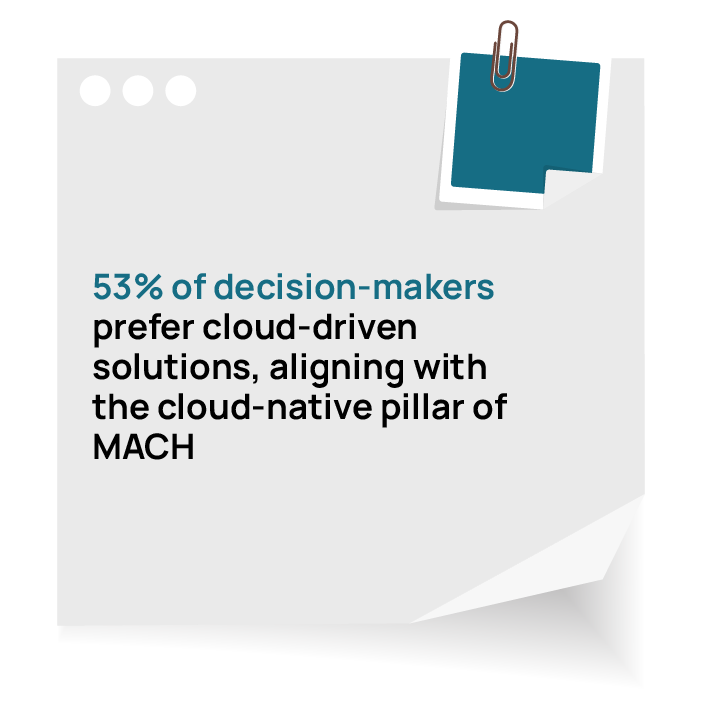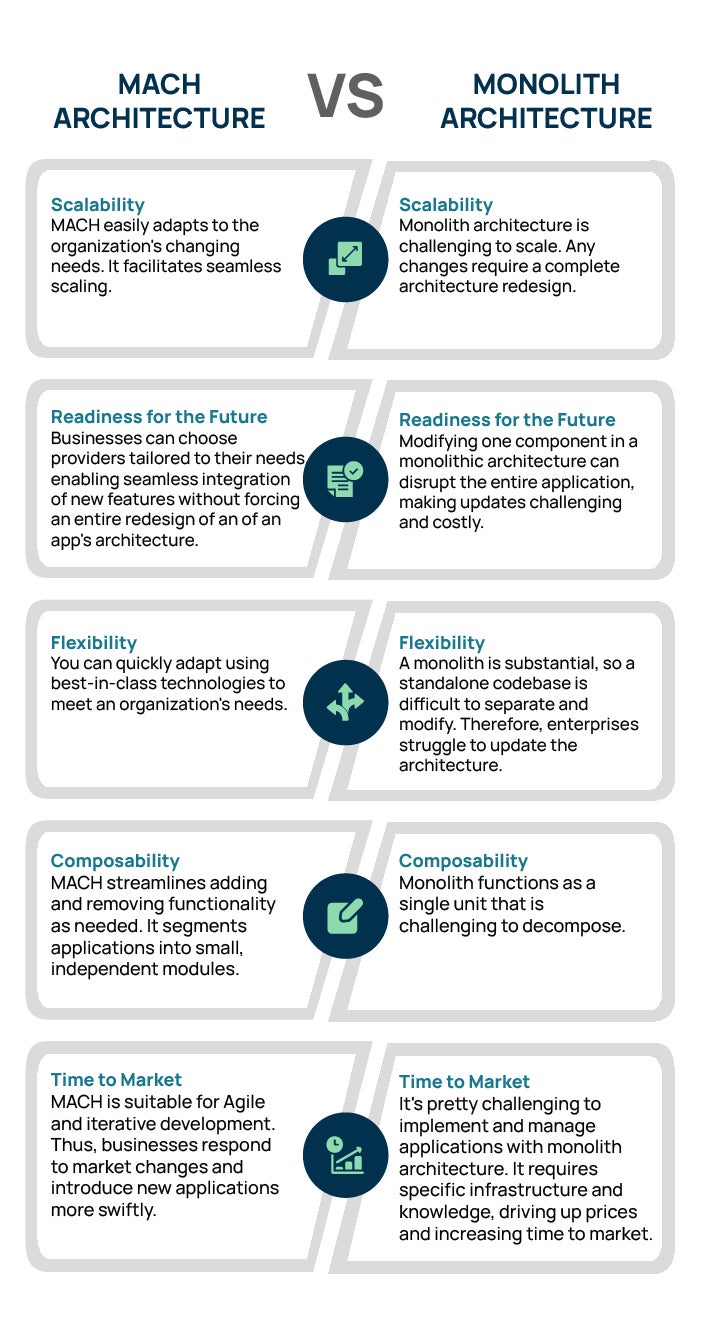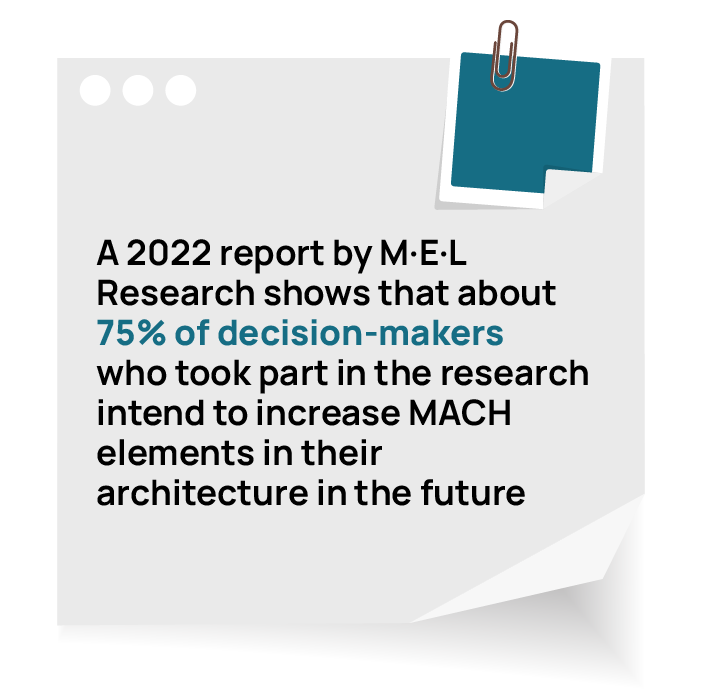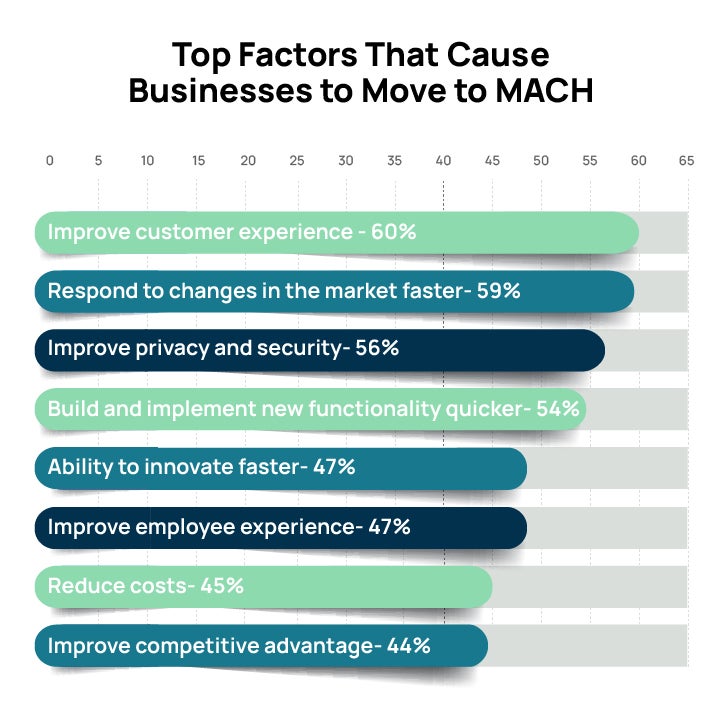Rising Tide of MACH Architecture in Modern Web Development
Discover details of MACH architecture in web development and MACH architecture for web developers. Understand how it shapes the digital era, allowing developers to create unique, scalable solutions.
Introduction to MACH Architecture
MACH Architecture is an advanced structure for creating digital experiences that integrates the ideas of microservices, API-first, cloud-native, and Headless, making it a cornerstone for MACH architecture in web development. It promotes a scalable, modular strategy that enables companies to quickly adjust to changing market conditions and customer needs by delivering best-in-class, independently deployable services. Addressing challenges in MACH architecture web development, this approach supports the composable enterprise model, facilitating easier integration of third-party and internal components. This improves maintainability, scalability, and the capacity to provide engaging, customized user experiences. Emphasizing adaptability and innovation, MACH Architecture is crucial for businesses aiming to leverage modern technologies to maintain competitiveness in the digital field of the 21st century.
The transition to MACH architecture in web development signifies a historic turning point from old monolithic architectures to a more modular, agile, and customer-centric approach. This shift, fueled by the rise of cloud technologies, an emphasis on API-first strategies, and the development of microservices and headless systems, shows the industry's response to the critical need for scalable, flexible, and fast-deployable digital solutions. MACH architecture current trends in web development offers organizations a robust foundation to adapt efficiently to market shifts and customer expectations, setting new standards for future web development techniques.

Pillars of MACH Architecture
Microservices
Essential to MACH architecture, microservices simplify web development by dividing it into small, independently deployable services that each handle a particular business function and are connected by APIs. Compared to monolithic systems, this approach allows for faster updates and better scalability without affecting the system as an entire unit. Microservices in modern web development are a major factor in the evolution of cloud-based applications because of their modularity, which facilitates scalable growth, streamlines maintenance, and speeds up deployment. They also provide a more effective and adaptable development process.
API-First
In order to guarantee smooth communication between services and make it easier to integrate with other systems, the API-first principle, which is a fundamental component of MACH architecture, emphasizes designing and building APIs early in a project. This method improves organizational flexibility and agility by allowing for the separate development and deployment of front-end and back-end systems, as well as the easy introduction of new features or updates. Businesses may effectively adjust to technology changes and consumer demands by giving priority to APIs, fostering a more creative and integrated digital ecosystem.
Cloud-Native
Cloud-native solutions are essential for taking full advantage of the scalability, reliability, and manageability that cloud computing offers. Cloud-native apps are efficient and flexible due to their use of containers, microservices, serverless architectures, and DevOps processes. This allows for quick deployment and flexibility in response to demand. Unlike previous monolithic architectures, this strategy enables services to be independently scaled and improved, greatly increasing an organization's capacity to maintain high availability and performance while lowering costs.
53% of decision-makers prefer cloud-driven solutions, aligning with the cloud-native pillar of MACH

[Source: M·E·L Research]
Cloud-native solutions, which provide a strong foundation for developing applications that smoothly satisfy changing user expectations, are becoming increasingly important as cloud adoption quickens for companies looking to maintain their competitiveness in the digital market.
Headless
One of the main components of MACH is headless principle, which transforms web development by separating the frontend presentation layer from the backend operations. This allows for unprecedented flexibility in content distribution across different platforms via API interaction. This method makes it easier to employ a variety of frontend technologies, giving developers the freedom to select the tools that work best for them or quickly switch frontends without having to completely rebuild the backend. It supports web, mobile, IoT, and AR/VR applications. Additionally, headless structure facilitates cloud-native applications, which are made to run as efficiently as possible on cloud infrastructure with scalable, resilient, and easily managed services. Modern JavaScript frameworks further enable these apps to deliver dynamic user experiences without sacrificing the effectiveness of content management.

Benefits of Adopting MACH Architecture
Adopting MACH architecture offers organizations a competitive edge through enhanced scalability, agility and innovation in web development. By analyzing and synthesizing the provided information, five distinct benefits of MACH architecture emerge, showcasing its transformative impact on businesses seeking to thrive in the digital era.
Enhanced Flexibility and Integration
MACH architecture allows the independent development, testing, and deployment of services by giving businesses the power to choose the optimal technology for each unique purpose. Because of its modular design, applications are kept up to date, quickly adjusted to changing business needs, and specifically designed to meet the needs of the organization.
A 2022 report by M·E·L Research shows that about 75% of decision-makers who took part in the research intend to increase MACH elements in their architecture in the future

[Source: M·E·L Research]
Scalability and Infrastructure Efficiency
MACH allows applications to flexibly grow, meeting varying demands without adding to the workload of infrastructure administration by utilizing cloud-native infrastructure. This guarantees that applications continue to be available and responsive, facilitating business expansion and allowing for easy market adaptation.
Rapid Development and Deployment
MACH design significantly shortens development durations by offering parallel work streams, enabling quick service testing, deployment, and modification. This flexibility increases competitive advantage by streamlining the delivery of applications and guaranteeing that projects are finished within scope, on schedule, and within budget.
Agility and Future-Proofing
Businesses may deploy new features or adjustments quickly because of the modular nature of MACH architecture, which is supported by robust API connections. Because of their agility, businesses can promptly adjust to changing market conditions and client demands while retaining relevance and user engagement.
Personalization and User Experience
Highly customized user experiences are made possible by MACH architecture's omnichannel distribution via APIs and ability to isolate content delivery from the presentation layer. Organizations may engage users with more relevant, context-aware interactions and increase customer satisfaction and loyalty by customizing content for different channels and devices.
Challenges and Considerations in Adopting MACH Architecture
While the benefits of MACH Architecture are compelling, adopting this approach also presents several challenges in MACH architecture web development and considerations that businesses must navigate:
Complexity of Managing Microservices
Migration to a microservices architecture significantly increases the difficulty of monitoring and coordinating a large number of independent services. Traditional management tools and practices may become overloaded by this complexity, which may result in inefficiencies and dependability concerns.
To mitigate this issue, organizations need to implement a strong automation and standardization plan in order to handle the complexity of microservices. Operations can be streamlined by putting into place complete coordination solutions that facilitate automated service deployment, scaling, and management. To further ensure that services function well together while retaining their independence, explicit standards for microservices development and communication can improve system coherence and reduce management workloads.
Security and Compliance in a Distributed Environment
The rising number of microservices, each acting as a possible point of risk, makes assuring security and compliance significantly more difficult. Data protection and regulatory compliance demand a comprehensive approach to security across a distributed architecture.
A comprehensive security strategy that includes best practices in microservices security is critical. This includes building a zero-trust model, providing secure service-to-service communication, and using API gateways to govern access and guard against attacks. Regular security audits and compliance checks should be integrated into the development lifecycle to remediate flaws quickly and ensure regulatory compliance, without relying on specific vendor solutions.
Adapting to Cultural and Organizational Shifts
In addition to altering technical frameworks, MACH architecture calls for a dramatic change in organizational culture and procedures, especially with regard to implementing DevOps and encouraging cooperation between development and operations teams.
Resistance from IT teams is a major barrier, noted by 40% of respondents, highlighting internal challenges to MACH adoption.

[Source: M·E·L Research]
To successfully handle this cultural shift, businesses should prioritize fostering a culture of ongoing learning and adaptation. This entails fostering cross-functional cooperation, offering tools and training to facilitate the adoption of DevOps methods, and fostering an atmosphere that welcomes experimentation and creativity. Businesses can better utilize MACH architecture's advantages and promote digital innovation by coordinating their organizational structures and procedures with its adaptable, flexible nature.

Role of MACH in Future Web Development Trends
The influence of MACH architecture on future web development trends is undeniably profound, poised to redefine the digital era through its agile, scalable, and innovative framework. Here are three key areas where MACH is set to make a significant impact:
Promoting API-first Development
As digital ecosystems become more interconnected, MACH's API-first approach is critical for enabling seamless integration and communication between diverse services and applications. This method ensures that systems are more flexible and adaptable to changes, paving the way for a more cohesive digital infrastructure that can support a broad array of functionalities and user experiences.
Driving Adoption of Headless CMS
MACH's headless architecture separates content management from the presentation layer, allowing for content to be delivered across multiple platforms without backend redevelopment. This flexibility is essential for businesses aiming to provide consistent, omnichannel experiences to their users, catering to the increasing consumer demand for personalized and accessible content on any device.
Enhancing System Scalability and Flexibility
The scalable and flexible nature of MACH architecture in web development, supported by microservices and cloud-native technologies, allows businesses to respond swiftly to market changes and user demands. This adaptability is crucial for supporting the rapid growth of digital services and applications, ensuring that businesses can scale their operations efficiently without compromising on performance or user experience.
Wrap Up
The rise of MACH Architecture in modern web development signals a major change in direction toward digital solutions that are nimbler, scalable, and focused on the needs of users. MACH addresses the current demands of organizations to adapt and succeed in a digital-first world by embodying the fundamental ideas of Microservices, API-first, cloud-native, and Headless technologies. It also sets a strong basis for future innovation. MACH Architecture stands out as a crucial model as businesses continue to manage the challenges of digital transformation. It provides a guide for creating adaptable, durable, and forward-thinking web applications that are ready to take on the changing demands of the digital age with ease and confidence, ushering in a new era of digital innovation.

By submitting this form I have read and acknowledged the Terms of Use and the Privacy policy
